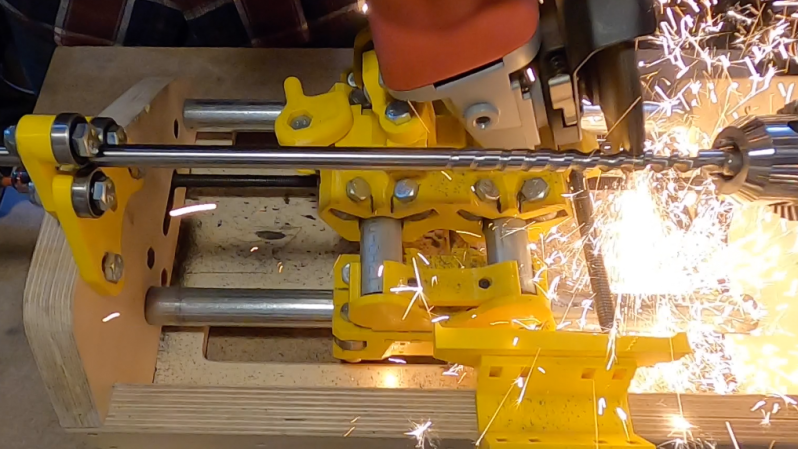In a world that’s literally awash in plastic waste, it seems a pity to have to buy fresh rolls of plastic filament to feed our 3D-printers, only to have them generate yet more plastic waste. Breaking that vicious cycle requires melding plastic recycling with additive manufacturing, and that takes some clever tooling with parts that aren’t easy to come by, like the compression screws that power plastics extruders.
This open-source compression screw grinder aims to make small-scale plastic recyclers easier to build. Coming from the lab of [Joshua Pearce] at the Michigan Technological University in collaboration with [Jacob Franz], the device is sort of a combination of a small lathe and a grinder. A piece of round steel stock is held by a chuck with the free end supported by bearings in a tailstock. On the bed of the machine is an X-Y carriage made of 3D-printed parts and pieces of electrical conduit. The carriage moves down the length of the bed as the stock rotates thanks to a pulley and a threaded rod, carrying a cordless angle grinder with a thick grinding wheel. A template attached to the front apron controls how deep the grinder cuts as it tracks along the rod; different templates allow the screw profile to be easily customized. The video below shows the machine in action and the complicated screw profiles it’s capable of producing.
We’ve seen lots of homebrew plastic extruders before, most of which use repurposed auger-type drill bits as compression screws. Those lack the variable geometry of a proper compression screw, so [Joshua] and [Jacob] making all the design documents for this machine available should be a boon to recycling experimenters.















What?? :) amazing movie.
Feeling cute, might cut some ballscrews later, IDK…
This article needs link to precious plastic so badly: https://preciousplastic.com/
https://www.youtube.com/watch?v=p4NoY33-Tfo
Maybe some of that “waste” could be used to armor people.
https://phys.org/news/2020-07-shock-dissipating-fractal-cubes-forge-high-tech.html
I wonder if an auger bit could be modified to work instead
Yes, but the key to proper extrusion as I understand it is having three different zones on the screw that do different jobs. Each zone has a different geometry to keep the raw plastic and melt it correctly. An auger bit only have one pitch and one thread depth, so it won’t work as well as a bespoke compression screw.
Redefining the phrase “Precision Ground”.
There is no need for the ground spiral itself to be very precise.
The only precision needed here is for the outside diameter, and that can easily be accomplished by using ground hand hardened rods as used for linear bearings.
It sure is a step up from the “precious plastic” youtube channel posted earlier. Then next step up would be to use a thinner grinding wheel and also move it axially. This would average out the wear on the grinding wheel and make the bottom of the groove straighter. This would need adding a few stepper motors, and a GRBL (or Tiny-G?) board.
I’ve done some similar grinding with an angle grinder, and the lack of precision in the bearings of the anglegrinder is a serious limitation for accuracy. (My application was to make a round bearing section on a hardened ballscrew spindle).
If this is open source, does that mean the design is open source, and includes the STL files?
Check out their linked paper/files. Not only the STL, but the whole thing is done in parametric FreeCAD, so you can tweak it to fit your locality’s pipe diameter, and you’re set.
Nice work! We had a couple of discussions about this method. Btw. a screw cost around 100$ on Robodig!. You can also do this on a manual lathe – I’ve done this dozen of times : https://www.youtube.com/watch?v=VAPhJLgrPAI&feature=emb_title
However, using a grinder makes rather an awful screw, it really needs to be polished to the max. Be prepared to polish it at high speeds – all day long, til a 3000 grid :-)
This is a great hack, although I wonder about the economics of it.
I am currently in the process of publishing a paper that goes into the economics of the project. Given that similar screws cost $100 the machine can be paid for after 3 screws if you don’t factor in labor cost.